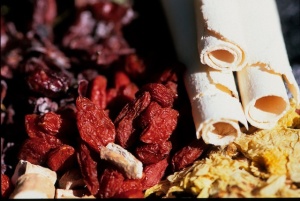 You know that saying, ‘The whole is greater than the sum of its parts’, well physicians of Chinese medicine have historically always utilized this idea when prescribing herbal medicines. It is well known that herbs work better in pairs or, better yet, in formulations of many herbs. Now even the modern scientists are noticing this to be true, for research is showing that when herbs are combined together their ability to fight disease is much greater than if the herbs were used alone. The important part is that the herbs need to be cooked together.
You know that saying, ‘The whole is greater than the sum of its parts’, well physicians of Chinese medicine have historically always utilized this idea when prescribing herbal medicines. It is well known that herbs work better in pairs or, better yet, in formulations of many herbs. Now even the modern scientists are noticing this to be true, for research is showing that when herbs are combined together their ability to fight disease is much greater than if the herbs were used alone. The important part is that the herbs need to be cooked together.
Seems, a bit Harry Porter really doesn’t it? I mean mixing a bunch of roots, leaves, fruits and seeds into a pot, boiling them away for half an hour, and then straining off some horrid tasting liquid is all a bit witchcraft and ferry-tale right? Why bother? Why not let the scientists investigate what the main active chemicals in the plants are and extract them. Put it all in a nice little pill and away we go. Cooking plants together seems so primitive doesn’t it.
Actually, this ancient art of cooking herbs together is being shown over and over again in laboratory settings to be a very important step. It seems that newer and more complex chemicals are formed when herbs are cooked together, ones that have profound effects. For example, when investigating the anti-inflammatory and anti-bacterial actions of the two herbs, Ku Shen (sophora flavescens) and Dang Gui (angelica sinensis), researchers found that they worked much better as a herb pair, rather than as isolated herbs. As a team, these two herbs had a much stronger effect at clearing such pathogens as E. coli, Staphylococcus aureus, and Shigella Castellani and Chalmers, while inhibiting the production of toxic inflammatory cytokines, including IL-1β, TNF-α, iNOS, ICAM-1, and COX-2. The researchers thus concluded that, “The study supports the hypothesis that the anti-pimple and anti-eczema activities … are attributed to herb pairs, A. sinensis and S. flavescens, used in combination”.
In another study, which was looking at the complexity of Chinese herbal medicine formulae, researchers found many interesting things with the 800 year old formula called Dang Gui Bu Xue Tang, which contains just two herbs: dang gui (angelica sinensis) and Huang Qi (Radix Astragali). Certain chemicals found within each herb were more available, with increased solubility and less oxidative destruction, when cooked together. This study looked even further than chemicals within the herbs, it actually looked at gene expression in individuals taking this medicine, finding that changes to at least 403 genes were specific to the herb pair, compared to using just the individual herbs used alone. Basically the herbs worked better when combined together.
Actually, the formula Dang Gui Bu Xue tang is traditionally used for those suffering with blood loss, who are weak and depleted. Researchers have found that this formula has the ability to increase hematopoiesis, which is the ability for the body to make more blood cells. A couple years ago, I had a patient who lost a lot of blood during the delivery of her second child. She came to me with a haemoglobin level in the 70’s, having a very pale and white complexion (even her palms were pale!). She was obviously told that a blood transfusion would be needed as she had severe anemia. She refused the transfusion and so I prescribed Dang Gui Bu Xue Tang (with some other herbs added) and within one week her haemoglobin jumped up to 110, which is basically 4 units of blood! This patient was actually a GP and was obviously very impressed, saying that there is no western medicine drug that can do such a thing.
Herbs are powerful, especially when they are cooked together. Need I say more…
Wishing you health,
Dr. Trevor Erikson
